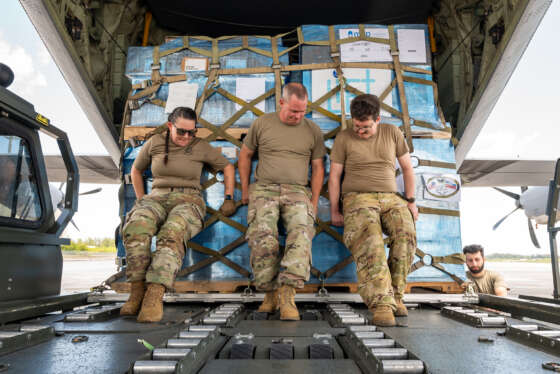There’s little doubt that the three agencies responsible for overseas contingency contracting have improved since the Wartime Contracting Reform Act of 2012 became law in December.
But recent audits show major problems in how the Defense and State departments and the U.S. Agency for International Development continue to spend billions of dollars in Afghanistan.
Exhibit A for the Senate Homeland Security and Governmental Affairs Subcommittee on Contracting and Financial Oversight Tuesday was an alert letter the Special Inspector General for Afghanistan Reconstruction (SIGAR) issued last week. It found DoD spent $34 million to build a command and control facility at Camp Leatherneck in Afghanistan in 2011 that the military didn’t want or need, and that the military awarded a contract a year after local commanders requested the project be canceled.
The facility, outfitted with office space and furnishings for a three-star general and up to 1,500 members of his division-level staff, has never been used. (View photos here.) Because the contractor constructed the building’s electrical infrastructure to U.S. specifications, it’s essentially useless to the Afghan government. So officials told the IG it will most likely be demolished.
Failed to meet terms of the contract
Richard Ginman, DoD’s director of pricing and acquisition policy, said the Army is investigating to determine accountability for the decisions leading up to the facility’s construction, which involved ongoing improvements to the building as late as early 2013.
“I have no ability to sit here and give you an answer as to how that occurred or why,” he said. “We need to let the investigation run its course, but at least from my perspective at this point, it defies logic.”
A separate report from SIGAR this week, released after the hearing, found that the contractor on a separate training facility for Afghan teachers failed to meet the terms of the contract. Auditors found that the building exposes Afghans to fire and electrical hazards, sewage and other health risks. But the Army Corps of Engineers paid the contractor in full without holding it accountable for the problems, according to SIGAR.
While problems continue, the progress by the three agencies to improve wartime contingency contracting over the last year is real.
Leaders from DoD, State and USAID testified on Capitol Hill about the steps they’ve taken to fix contingency contracting, including checking several boxes on a long list of reforms Congress mandated in this year’s Defense authorization bill. They cited gains in developing clearer lines of responsibility for contracting, better oversight and better data collection.
In 2011, the Commission on Wartime Contracting concluded that the government wasted between $30 and $60 billion in Iraq and Afghanistan. But on Wednesday, Sen. Claire McCaskill (D-Mo.), who helped create the independent commission, acknowledged that contingency contracting has improved.
“It is much better than it was in 2007 in every single one of your agencies,” she said.
Who’s in charge?
Ginman said DoD has taken steps to introduce more accountability, responding to one of the provisions in last year’s law that requires it to establish a chain of authority for policy, planning and execution of contract support.
“I refer to this as the ‘who’s in charge’ question,” he said.
Ginman said DoD continues to implement a 2009 directive that attempted to establish clear lines of responsibility at the highest levels of the Pentagon.
“It lays out clearly who’s in charge,” he said. “At the end of the day, it’s Secretary Hagel, but you have the undersecretary for personnel and readiness who has responsibilities for managing the force, of which contractors are a piece. The undersecretary for acquisition, technology and logistics has very clear responsibilities when it comes to the issues of contracting and the management of contractors on the battlefield. We have the comptroller who has very clear responsibilities with the funding and what we’re doing with it. The undersecretary for policy has very clear responsibilities as well.”
DoD also has made major strides in overseas contract oversight performed by contracting officer representatives, increasing their ranks from 40 trained four years ago to more than 400 now.
A more difficult and more important step, Ginman said, is to inculcate the notion throughout the military that deployed commanders are responsible for contracting that happens in their battlespace.
“It’s not the policy — it’s the doctrine and getting that to a point where everyone understands what it is,” he said. “It’s the professional training; it’s the execution; it’s the exercises. We’re encouraged when we see that both Gen. [David] Petraeus and Gen. [John] Allen sign letters out that say that contracting is the commander’s business. When you have 100,000 people on a battlefield, getting that so that it’s understood is far and away the largest gap that we have. It is one that we’re actively working on, but it’s not one we’re going to solve today or tomorrow. We have a long way to go.”
Oversight process at USAID
At USAID, Aman Djahanbani, the agency’s senior procurement executive, said there’s been an increase in accountability and oversight. He said USAID has set up a new accountability review process involving its senior leadership.
“All new awards at the $25 million level will be validated by an assistant administrator to ensure that the project meets several accountability criteria, including a demonstrated commitment to sustainable results,” he said. “Additionally, the administrator himself will provide the final authorization for awards at or above $75 million.”
DoD, USAID and State say they’re also responding to mandates to report contractors’ performance into a central database, the Past Performance Information Retrieval System, so that it can be used by procurement officers during future awards. The Office of Management and Budget wants agencies to report performance data on all of their contracts by 2015.
DoD says it’s currently reporting on about 80 percent of its contracts.
Djahanbani said USAID began from a baseline of about 14 percent last year and now is reporting about 27 percent.
“But as the end of the fiscal year comes to a close, that number will go up,” he said. “We’ve also set aside November as our ‘past performance month.’ We’re going to have a stand-down day to make sure we achieve 65 percent, well on our way to 100 percent in calendar year 2015.”
The State Department is not using stand down days, but Patrick Kennedy, the undersecretary for management, said it’s issued orders to its contracting staff to begin adding performance information to the governmentwide database.
“We’ve started out, I’ll fully admit, from a pathetic base,” he said. “We’ve doubled it though to 17 percent, and by the end of the fiscal year we believe we’ll be at 40 or 45 percent.”
RELATED STORIES:
” target=”_blank”>Senate’s defense bill cuts civilian workforce, caps contractor salaries





